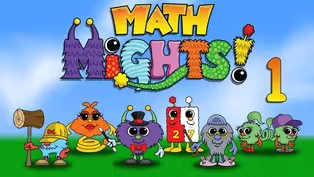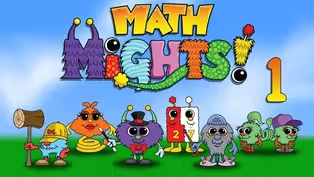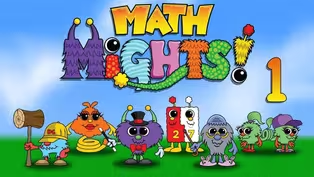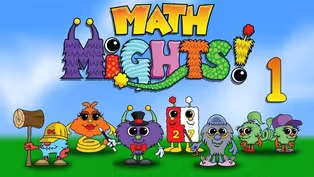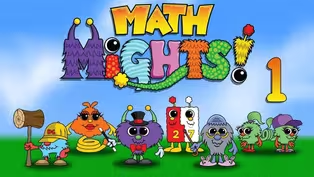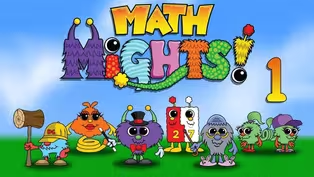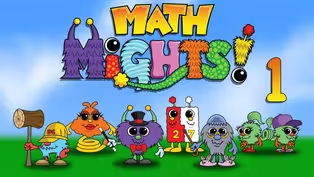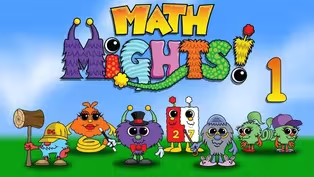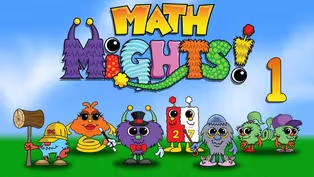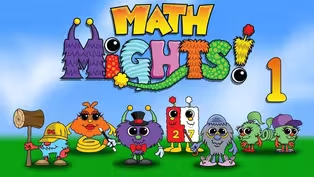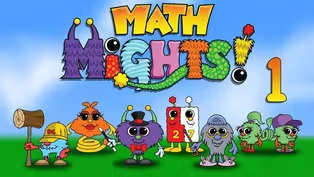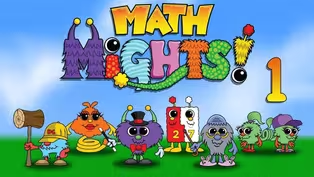Math Mights
Add Tens and Ones
Season 3 Episode 303 | 15m 59sVideo has Closed Captions
Join Mrs. Markavich for a word problem with her friend Professor Barble!
Join Mrs. Markavich for a word problem with her friend Professor Barble! Get ready to have some fun adding tens and ones with ten frames and with a game called "What did I Add"!
Problems playing video? | Closed Captioning Feedback
Problems playing video? | Closed Captioning Feedback
Math Mights is a local public television program presented by Detroit PBS
Math Mights
Add Tens and Ones
Season 3 Episode 303 | 15m 59sVideo has Closed Captions
Join Mrs. Markavich for a word problem with her friend Professor Barble! Get ready to have some fun adding tens and ones with ten frames and with a game called "What did I Add"!
Problems playing video? | Closed Captioning Feedback
How to Watch Math Mights
Math Mights is available to stream on pbs.org and the free PBS App, available on iPhone, Apple TV, Android TV, Android smartphones, Amazon Fire TV, Amazon Fire Tablet, Roku, Samsung Smart TV, and Vizio.
Providing Support for PBS.org
Learn Moreabout PBS online sponsorshipMore from This Collection
Video has Closed Captions
Join Mrs. Markavich for a missing addend word problem with Professor Barble! (16m 5s)
Adding Tens-Tens and Ones-Ones
Video has Closed Captions
Join Mrs. Markavich for a missing addend word problem with Professor Barble! (15m 35s)
Write Equations to Match the Strategy
Video has Closed Captions
Join Mrs. Markavich for a missing addend word problem with Professor Barble. (16m 2s)
Video has Closed Captions
Join Mrs. Markavich for a subtraction word problem with Professor Barble. (15m 59s)
Video has Closed Captions
Join Mrs. Markavich for a missing addend word problem. (16m 6s)
Add 2-Digit Numbers & Write Equations
Video has Closed Captions
Join Mrs. Markavich for a word problem with her friend Professor Barble! (15m 59s)
Comparing Numbers Different Ways
Video has Closed Captions
Value Pak shows you the different ways to compare 2-digit numbers. (15m 44s)
Video has Closed Captions
Join Mrs. Markavich for a word problem with her friend Professor Barble! (15m 59s)
Decompose/Compose #'s Different Ways
Video has Closed Captions
We show you different ways to decompose and compose 2-digit numbers! (15m 59s)
Video has Closed Captions
Join Mrs. Markavich & Dotson to talk about numbers with the Counting Buddy Senior! (16m)
Video has Closed Captions
Join Mrs. Markavich & Dotson for a Numeracy Talk with the Counting Buddy Senior (16m)
Video has Closed Captions
Join Mrs. Markavich for Numeracy Talk with Dotson working on conservation to 20. (16m)
Providing Support for PBS.org
Learn Moreabout PBS online sponsorship(playful music) (sparkling sound) - Welcome first graders.
I'm Mrs. Markovich and I'm so excited that you're here with me today.
Today, we're going to take a look at what we'll be doing on our plan.
Our plan for the day is to solve some word problems with our friend Professor Barble and then we'll be adding tens and ones.
The first thing I want to do is warm up our math brain and we're going to do that with our friend, Professor Barble.
Here he comes.
This is my friend, Professor Barble and Professor Barble is a friend in Mathville and he loves to solve word problems.
If he slows down his thinking and he doesn't rush to get an answer and he pushes on his cap, this really cool pole will come out with all kinds of arrows on it.
And the arrows will help him how to solve the problem and in what direction to go in when we're solving math problems.
Let's take a look at a visual model because a visual model will help us to solve problems.
Here is an example of what a visual model is.
Sometimes a visual model is a drawing, it could be a unit bar, a tape diagram, or a bar model.
Another really important thing about a visual model is that it helps with reading comprehension and strategies for the word problem.
And finally, drawing a visual model helps to visualize the strategies.
Visualize means to make a picture in your brain and it helps us to understand what the word problem is asking.
I've got a word problem for us to solve today.
Let's take a look at what it usually looks like in first grade.
Usually our problem looks like this.
There'll be a story problem or a problem with words at the top.
Then there'll be another section with a sentence form.
You'll see a visual model or even a unit bar and then at the bottom, there was a space for us to show our work or to write an equation or even a number bond.
My problem for today is a story problem.
It says Mark has nine strawberries.
Six of them are small and the rest are large.
How many large strawberries does Mark have?
My first friend Ming says I think maybe we should add to solve this problem.
And Keshawn says wait, or do we subtract?
Wow, Professor Barble says hold on, guys, let's slow down.
We're gonna push on my cap so my pole pops up and it'll lead us in the direction of how to solve a visual model.
There are some specific steps that we need to follow.
So the first step is to read the entire problem and to put it in chunks or little parts because what we want to do is organize the information.
So let's do that first.
I'm going to read you the sentence and you're going to echo it back to me.
Let's try it and as we do it, we're going to chunk it for important parts of information.
And sometimes when you hear that information, you can say information.
Let's try it.
Mark has nine strawberries, you read it.
Oh, I think I heard someone say information.
The next part says six of them are small.
Let me hear you say it.
Ooh, I think I heard another friend say information.
Let's keep reading.
And the rest are large, let me hear you.
Ooh, I heard another friend say information.
The next part says how many large strawberries does Mark have?
You say it.
Oh, I heard another friend say that there was information.
Now I want to talk about another important part in our visual model process, it's step two.
And in step two, we rewrite the question in a sentence form.
And we do that because we need to slow down and we need to organize our information and know exactly what it is we're trying to solve.
So for example on this one, I'm gonna help you out a little bit.
It's going to say this.
Mark has hmm large strawberries.
I want to hear you say it, try it on your own.
Great job, I heard you echo that back to me.
Now, step number three is to determine who or what is involved in the problem.
We know that the who is our friend Mark and the what is the strawberries.
Now that we have that, we're going to move on to step four which is to draw the unit bar.
This is important because it helps us to organize our information and not to rush for an answer.
Step five is to check when each chunk has been added and then write the question mark.
Mark has nine strawberries.
Let's head over to our board where we can add that information and let's do one, two, three, four, five, six, seven, eight, nine.
I'm going to put the whole number nine right here at the end, nine.
And then I'm going to go back to my problem and check it off, check.
Let's look at our next part.
It says six of them are small.
Let's head over to our board and fill in that information.
I have one, two, three, four, five, six.
I'm going to label this small, S-M-A-L-L. Don't forget to go back and check it, check.
The next part says and the rest are large.
That means this portion right here is the large part.
So I'm going to write the word large right on that space, label it large, L-A-R-G-E, large.
And then I'm going to go back to my problem and check it off, check.
My last part says how many large strawberries does Mark have?
That's where I have to add my question mark.
So right up here on this line, this was the part of the information I had been looking for the whole entire time.
That's the hmm.
Don't forget to check this off in your problem, check.
My last part is to compute or solve the problem.
So let's take a look at what that looks like.
My friend says oh, now I see what the problem was asking for.
It's this part right here.
This was the large part and let's count to see how many were large.
One, two, three.
I have three parts or three strawberries that were large.
If I want to put that into a math equation, I can do it like this.
I take the whole number and remember the whole number was nine.
You're going to do a subtraction sign because we're gonna take away the part we knew which was the small part.
Remember, that was six, an equal sign and then our hmm, that was this part, the part we didn't know, let's count that together.
One, two, three.
So my answer is three.
And you want to make extra sure that you go back to the last step right here that Mark has three large strawberries.
Now, let's head on over and take a look at our I can statement of the day.
Our I can statement says I can add tens and ones to two-digit numbers.
Let's take a look at some 10 frames.
How do you see them?
How many do you see?
Well, Ming says 30.
I see three 10 frames that are full.
One, two, three, 10, 20, 30.
Great job, Ming.
Now, like we did in our number talks with our friend Dodson, I want you to take a picture of this and hold it in there because it's gonna change just a little bit.
Are you ready?
Let's take a look at it.
How many do you see?
How do you see them?
Well, my friend says 35.
I see there is three 10 frames full and then three red and two yellow make five.
I know that 30 plus five is 35.
Let's take a look at that on my board.
I have 10, 20, 30, and then I have some more.
I have three red and two yellow.
And I know that 10, 20, 30, 31, 32, 33, 34, 35.
Great job, Keshawn.
Now, it's going to change one more time, friends, so remember take that picture of what you saw and then think about what the new one is.
Here we go.
How many do you see and how do you see them?
Ming says I see 39.
I see that if there was one more, it would be four full 10 frames, which would be 40 since one is missing from right here.
If that was there like that and we took it away, if one is missing, that would be 39.
Great job with the 10 frames, seeing tens and ones.
Now you're going to get to play a game called What Did I Add?
Let's take a look at it.
Our partner A flips over a number with the place value strips to create a two-digit number, for example, 54.
Then player B draws a secret number and can decide to add that many tens or ones to the number.
I'd like to show you what that looks like.
Let's take a look at mine.
I have the number 54 in front of me.
I have five tens and four ones.
Player B is going to have some secret cards.
Let's say that player B draws the number four.
Player B can choose to add four ones or they could be really tricky and add four tens.
Now, partner B says the new sum and partner A has to guess what was added.
Now, it's time to figure out that missing number.
Let's look at our problem.
54 plus hmm equals 84.
When I look at it, I can see that they both have the same amount of ones.
So I'm gonna know that that is the same and I'm going to move them.
I'm gonna move four ones down here and the four ones down here.
And now I'm looking at two numbers, 50 and 80.
If I think about it, I think that maybe they counted by tens.
Let's try it.
50, 60, 70, 80, that's one, two, three tens.
So I think that that hmm is the number 30.
Let's check it out.
It is 30.
I'm gonna put the four back up here in the 54 and the four back up here in the 84 and I know that 54 plus 30 equals 84.
Wow, that was some great thinking.
Now that we had a chance to practice the game together, let's play it.
Ming and Keshawn want to be partners.
Ming will be partner A, let's take a look at her number.
She picked the number 81.
Keshawn is partner B and he has that mystery number.
I wonder what it is.
Keshawn says the sum of 81 and my secret number is 85.
What number did I add?
Well, let's take a look at that here.
I've got 81 plus hmm equals 85.
When I take a really close look at it, I can see that both numbers have an eight and the eight is on the 10 side.
I'm gonna just slide that down so you can see it here and you can see this is 80 and this is 80.
So I'm thinking that the ones are what have to change and let's count on and see if that's possible.
I'm gonna slide this back up here so that you can see the whole number 81.
And I'm going to count on and stop when I get to 85 and see what I counted.
So I want you to say 81 and then keep counting.
82, 83, 84, 85.
That would be one, two, three, four ones.
Let's take a look and see if that was Keshawn's number.
Are you ready?
Ooh, it is four.
He did add four ones.
So Keshawn says 81 plus my secret number four gives me 85.
81 plus four equals 85.
Great thinking, Keshawn.
Let's take a look at these two equations.
43 plus five equals 48 and 43 plus 50 equals 93.
What do you notice?
If we look at it on my board, we can see 43 plus five equals 48.
You can see right here my ones have changed because I added five ones.
They both have the same amount of tens.
When I looked down at the bottom equation, 43 plus 50 equals 93, the ones stayed the same in the bottom equations, but the tens have changed.
I have four tens plus five tens equals nine tens.
I'm just gonna slide that out of here so you can see that just a little better.
40 plus 50 would give us 90.
The ones never changed.
Now it's your turn to play What Did I Add?
I hope that you have a partner that you can play this game with and you have an absolute blast.
Until I see you next time, kiss your brains.
Thanks, Math Mights.
(playful music) - [Boy] Sis4teachers.org.
- [Girl] Changing the way you think about math.
- [Woman] This program is made possible with funding from the Michigan Department of Education, Governor's Education Emergency Funds, the state of Michigan, and by viewers like you.


- Home and How To

Hit the road in a classic car for a tour through Great Britain with two antiques experts.










Careers that Work

Support for PBS provided by:
Math Mights is a local public television program presented by Detroit PBS
